Lost your phone? Worried about someone tracking your every move? Look no further! In this article, we unveil eight insightful signs to help you detect phone tracking and empower you with prevention methods. Keep your privacy intact with these handy tips!
Adjusting Location Settings on Your Phone
To adjust your location settings on your phone, follow these steps:
1. Open the Settings app on your smartphone.
2. Scroll down and tap on “Privacy” or “Location” (depending on your device).
3. Look for an option that says “Location Services” or “Location Settings” and tap on it.
4. You will see a list of apps that have access to your location. You can toggle the switch next to each app to turn off location access for that specific app.
5. If you want to completely disable location services, you can toggle off the main switch at the top of the screen.
6. Keep in mind that some apps and features may require location services to function properly. Choose your settings accordingly.
7. Adjusting your location settings can help protect your privacy and prevent unnecessary tracking of your phone.
By taking control of your location settings, you can ensure that your smartphone is not sharing your location data without your consent.
Limiting Ad Tracking on Your Devices
To limit ad tracking on your devices and protect your privacy, follow these steps:
1. iOS Devices:
– Go to “Settings” and select “Privacy.”
– Tap on “Tracking” and enable “Allow Apps to Request to Track.”
– Disable tracking for specific apps by toggling off the switch next to each app.
2. Android Devices:
– Open the “Settings” app and select “Google.”
– Tap on “Ads” and enable “Opt out of Ads Personalization.”
– Reset your advertising ID to prevent targeted ads.
3. Use a VPN:
– Install a reputable VPN (Virtual Private Network) app on your device.
– Enable the VPN to encrypt your internet connection and hide your location from advertisers.
4. Review Privacy Settings:
– Regularly review the privacy settings on your devices and apps.
– Disable unnecessary location services and permissions for apps.
By following these steps, you can take control of your ad tracking and protect your privacy from companies that collect your data for targeted advertising.
Preventing Google from Tracking Your Activities
If you want to prevent Google from tracking your activities, here are some methods to consider:
1. Disable Location Services: Go to your phone’s settings and turn off location services to limit the GPS tracking capabilities.
2. Opt Out of Google’s Ad Personalization: Visit Google’s Ad Settings page and disable personalized ads to reduce the amount of data Google collects.
3. Use Private Browsing Mode: Enable private browsing mode in your browser to prevent Google from tracking your online activity.
4. Clear Your Browser History: Regularly clear your browser history and cache to remove any stored information that Google may use for tracking.
5. Block Tracking Cookies: Install browser extensions or plugins that block tracking cookies, such as “Disconnect” or “Ghostery”.
Remember, maintaining your privacy requires ongoing vigilance. Stay informed about the latest tactics and techniques used by companies like Google to track your activities, and adjust your settings accordingly.
Stay in control of your personal information and protect your privacy.
Exploring Alternative Browsers for Privacy
Looking for a browser that prioritizes your privacy? Here are some signs that your phone may be tracked and prevention methods to keep your data secure.
1. Unusual battery drain: If your battery is draining quickly, it could be a sign of a tracking app running in the background. Check your phone’s battery usage settings to identify any suspicious activity.
2. High data usage: Excessive data consumption can indicate unauthorized tracking. Monitor your data usage and investigate any spikes or unusual patterns.
3. Location discrepancies: If your device shows inconsistent location data or moves unexpectedly, it may be compromised. Disable GPS and location services for apps that don’t require them.
4. Unwanted ads: Persistent targeted ads could mean your phone is being tracked. Install an ad-blocking browser extension to limit data collection and improve privacy.
5. Privacy-focused browsers: Consider using alternative browsers like Microsoft Edge or Mozilla Firefox, which prioritize user privacy and offer built-in tracking protection features.
Remember, your privacy is not a commodity. Take control of your data and protect your online presence by being aware of these signs and implementing the necessary prevention methods.
Monitoring and Securing Your Online Accounts
1. Regularly check your online accounts for any suspicious activity or unauthorized access.
2. Enable two-factor authentication whenever possible to add an extra layer of security.
3. Keep your passwords strong and unique, and avoid using the same password for multiple accounts.
4. Be cautious of phishing emails and never click on suspicious links or provide personal information.
5. Update your devices and software regularly to protect against known vulnerabilities.
6. Use reputable security software, such as Microsoft Defender, to scan for and remove any malware or viruses.
7. Be mindful of the permissions you grant to apps and websites, and review your privacy settings regularly.
8. If you suspect that your online accounts have been compromised, change your passwords immediately and contact the respective service providers for further assistance.
Remember, staying vigilant and taking proactive steps can help protect your online accounts from unauthorized access and potential data breaches.
Opting Out of Targeted Advertisements
1. To opt out of targeted advertisements, follow these steps:
a. Go to the settings on your mobile phone.
b. Look for the “Privacy” or “Ads” section.
c. Disable the option for “Personalized Ads” or “Ad Tracking”.
2. Additionally, you can install ad-blocking software or browser extensions to further prevent targeted ads.
3. Remember to regularly update your phone’s operating system and apps to ensure you have the latest security patches.
4. Be cautious when downloading apps or granting permissions, as some may track your location or collect data without your consent.
5. Consider using a virtual private network (VPN) to encrypt your internet connection and protect your privacy.
By taking these simple steps, you can regain control over the advertisements you see and protect your personal information from being tracked.
Ensuring the Privacy of Virtual Assistants
When using virtual assistants, it’s important to prioritize privacy. Here are some tips to keep your information secure:
1. Review Privacy Settings: Take the time to review the privacy settings of your virtual assistant. Ensure that only necessary permissions are granted.
2. Limit Data Collection: Be cautious about the data you share with your virtual assistant. Avoid giving unnecessary personal information that could be used for tracking.
3. Regularly Update Software: Keep your virtual assistant’s software up to date. Updates often come with improved security features.
4. Use Strong Passwords: Protect your virtual assistant by using a strong and unique password. Avoid using common or easily guessed passwords.
5. Be Mindful of Third-Party Apps: When integrating third-party apps with your virtual assistant, carefully review their privacy policies and permissions.
6. Enable Two-Factor Authentication: Add an extra layer of security by enabling two-factor authentication for your virtual assistant.
Remember, your privacy is our priority. Follow these tips to ensure a secure and private virtual assistant experience.
For more information on privacy and virtual assistants, visit our website.
Managing App Permissions for Privacy Control
- Understand the App Permissions: Familiarize yourself with the different types of permissions that apps may request, such as access to your camera, contacts, or location.
- Review Permissions Before Installing: Before downloading an app, carefully review the permissions it requires and consider whether they are necessary for its functionality.
- Manage App Permissions: Regularly review and manage the permissions granted to your installed apps to ensure they align with your privacy preferences.
- Revoke Unnecessary Permissions: Identify apps that have unnecessary permissions and revoke them to limit their access to your personal information.

- Keep Apps Updated: Install updates for your apps regularly to ensure you have the latest security features and privacy controls.
- Use App Permissions Settings: Take advantage of the built-in app permission settings on your device to restrict or allow access on a case-by-case basis.

- Consider App Alternatives: Explore alternative apps that prioritize privacy and offer more granular control over permissions.
- Regularly Review App Privacy Policies: Stay informed about how apps handle your data by reviewing their privacy policies regularly.
Understanding Methods of Phone Tracking
Phone tracking is a concerning issue that can compromise your privacy and security. To help you prevent unauthorized tracking, here are 8 signs to watch out for and some prevention methods.
1. Unusual battery drain or overheating: If your phone is draining battery quickly or getting hot without a reason, it could be a sign of phone tracking.
2. Strange behavior: Pay attention to any unexpected behavior, such as apps crashing or settings changing on their own.
3. Suspicious data usage: If you notice a sudden increase in data usage, it could indicate that your phone is being used for tracking purposes.
4. Unfamiliar apps or services: Check your phone for any unfamiliar apps or services that you didn’t install or authorize.
5. Poor performance: If your phone is slowing down or experiencing lag, it may be a result of phone tracking.
6. Unusual background noise during calls: If you hear strange noises during phone calls, it could be a sign of someone monitoring your conversations.
7. Increased data traffic: Watch for unusually high data traffic even when you’re not actively using your phone.
8. GPS location discrepancies: If your phone’s GPS shows inaccurate or inconsistent location information, it could be a sign of phone tracking.
To protect yourself from phone tracking, take the following prevention methods:
1. Keep your phone software up to date to patch any vulnerabilities.
2. Install a reliable security app that can detect and block tracking attempts.
3. Regularly review and manage app permissions to limit access to your personal data.
4. Avoid downloading apps from unknown sources and only use trusted app stores.
5. Be cautious when connecting to public Wi-Fi networks, as they can be used for tracking.
6. Use a strong and unique passcode or biometric authentication to secure your phone.
7. Disable unnecessary location services and only enable them when needed.
8. Consider using a VPN (Virtual Private Network) to encrypt your internet traffic and protect your privacy.
By staying vigilant and following these prevention methods, you can protect yourself from phone tracking and safeguard your privacy.
Recognizing Signs of Phone Tracking
1. Unusual battery drain: If your phone’s battery is draining quickly, it could be a sign of phone tracking. Check your battery usage to see if any unfamiliar apps are consuming a large amount of power.
2. Increased data usage: Phone tracking apps often require internet connectivity to transmit data. Keep an eye on your data usage and look for any significant spikes that cannot be explained by your normal usage.
3. Suspicious background noise: If you hear strange noises or echoes during phone calls, it could indicate that your phone is being tapped or tracked. Be cautious if this happens frequently.
4. Unusual behavior: If your phone starts acting strangely, such as freezing, crashing, or displaying unusual pop-ups, it could be a sign of phone tracking. Scan your device for malware and suspicious apps.
5. Unexpected shutdowns: If your phone shuts down unexpectedly or restarts without any apparent reason, it could be a red flag for phone tracking. Run a thorough scan for viruses and suspicious activity.
6. Difficulty turning off or powering on: If you find it challenging to turn off or power on your phone, it might indicate that someone has gained control over your device. Take immediate action to investigate and secure your phone.
7. Strange text messages or calls: If you receive unusual text messages or calls from unknown numbers, it could be an attempt to track your phone. Avoid responding to or engaging with these messages.
8. Unfamiliar apps or software: Check your phone for any unfamiliar apps or software that you did not install. These could be tracking tools. Remove any suspicious apps and regularly review your installed applications.
Remember, prevention is key. Always keep your phone’s software up to date, use strong and unique passwords, and be cautious about downloading apps from unknown sources.
Addressing Phone Tracking Concerns and FAQs
- Understanding Phone Tracking: Learn about the different methods used to track your phone and the potential risks involved.
- Signs of Phone Tracking: Discover eight common signs that may indicate your phone is being tracked without your knowledge.

- Prevention Methods: Explore effective strategies to protect your phone from unwanted tracking attempts.
- Installing Security Apps: Find out how installing trusted security apps can help detect and prevent phone tracking.
- Regular Software Updates: Learn why keeping your phone’s operating system up to date is crucial for enhancing security and minimizing tracking risks.
- Securing Personal Information: Understand the importance of safeguarding your personal data and implementing strong privacy settings.

- Avoiding Suspicious Links: Discover how to identify and avoid clicking on suspicious links or downloading malicious apps that could lead to phone tracking.
- Legal Implications: Gain insights into the legal aspects surrounding phone tracking and your rights as a phone user.
- FAQs: Get answers to frequently asked questions about phone tracking, privacy concerns, and best practices for maintaining phone security.
Protecting Mobile Security with McAfee
Protecting your mobile security is crucial in today’s digital world. With McAfee, you can ensure the safety of your mobile device from potential threats. Here are 8 signs to watch out for and prevention methods to keep your phone secure:
1. Unusual battery drain or slow performance: Run a scan using McAfee Mobile Security to detect any malware or malicious apps that may be causing these issues.
2. Unexpected data usage: This could be a sign of malware running in the background. Enable McAfee’s data monitoring feature to track and control your data usage.
3. Pop-up ads and redirects: These can be indications of adware or phishing attempts. Enable McAfee’s ad-blocking feature to avoid these intrusive ads.
4. Unauthorized access to accounts: If you notice suspicious activity or login attempts, change your passwords immediately and enable two-factor authentication.
5. Lost or stolen device: Enable McAfee’s device tracking feature to locate your phone, lock it, or remotely wipe your data if necessary.
6. Fake app downloads: Stick to trusted app stores like Google Play or the App Store, and regularly update your apps to prevent malware from sneaking in.
7. Phishing attempts via email or SMS: Be cautious of suspicious links or requests for personal information. Do not click on unfamiliar links and avoid sharing sensitive information.
8. Outdated operating system: Keep your device’s operating system up to date. Enable automatic updates to stay protected from known vulnerabilities.
By following these prevention methods and utilizing McAfee’s mobile security features, you can safeguard your device and protect your personal information. Stay one step ahead of potential threats and enjoy a worry-free mobile experience.
Identifying Potential Phone Number Stalking Risks
If you suspect that your phone number is being stalked, there are several signs to watch out for and prevention methods to safeguard your privacy.
1. Unusual Call Behavior: Pay attention to frequent hang-ups, silent calls, or calls from unfamiliar numbers.
2. Persistent Text Messages: Excessive, unwanted, or threatening texts can be a sign of stalking.
3. Location Tracking: Check if your phone’s location services are unexpectedly activated or if someone knows your whereabouts without your consent.
4. Suspicious Online Activity: Be cautious if you notice strange friend requests, messages, or posts on social media platforms.
5. Unfamiliar Apps or Software: If you find unknown apps or software on your device, it could indicate unauthorized access.
6. Increased Mobile Data Usage: Excessive data consumption may suggest that someone is using your phone without your knowledge.
7. Battery Drain: Unexplained battery drainage can be a result of background surveillance activities.
8. Strange Noises During Calls: If you hear background noises or echoes during calls, it could mean your phone is compromised.
Prevention Tips:
– Regularly update your phone’s software and security settings.
– Install reliable antivirus and anti-stalking apps.
– Be cautious when sharing your phone number online.
– Disable location services for apps that don’t require it.
– Use strong, unique passwords for all your accounts.
– Enable two-factor authentication for added security.
By staying vigilant and taking proactive measures, you can protect yourself from potential phone number stalking risks.
Taking Steps to Prevent Phone Number Tracking
1. Disable Location Services: Go to your phone’s settings and turn off location services to prevent your phone number from being tracked.
2. Avoid Sharing Personal Information: Be cautious about sharing your phone number online or with unknown sources to minimize the risk of tracking.
3. Use Privacy Settings: Adjust your privacy settings on social media platforms and other apps to restrict access to your phone number.
4. Install a VPN: A Virtual Private Network (VPN) can help protect your phone number by encrypting your internet connection and masking your IP address.
5. Regularly Update Software: Keep your phone’s operating system and apps up to date to ensure you have the latest security patches and protections against tracking.
6. Be Cautious of Suspicious Links: Avoid clicking on unknown links or downloading suspicious apps, as they may contain tracking software.
7. Limit Bluetooth Usage: Disable Bluetooth when not in use, as it can be used to track your phone’s location.
8. Use Anti-Tracking Apps: Consider installing anti-tracking apps that can detect and block attempts to track your phone number.
By following these prevention methods, you can take proactive steps to protect your phone number and maintain your privacy.
